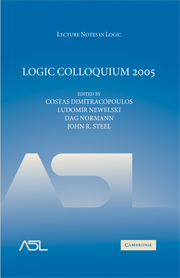Book contents
- Frontmatter
- Contents
- Introduction
- Speakers and Titles
- Thread algebra and risk assessment services
- Covering definable manifolds by open definable subsets
- Isomorphisms and definable relations on computable models
- Independence for types in algebraically closed valued fields
- Simple groups of finite Morley rank
- Towards a logic of type-free modality and truth
- Structural analysis of Aronszajn trees
- Proof analysis in non-classical logics
- Paul Bernays' later philosophy of mathematics
- Proofnets for S5: Sequents and circuits for modal logic
- Recursion on the partial continuous functionals
- A transactional approach to the logic of truth
- On some problems in computable topology
- Monotone inductive definitions and consistency of New Foundations
- LECTURE NOTES IN LOGIC
Paul Bernays' later philosophy of mathematics
Published online by Cambridge University Press: 18 December 2009
- Frontmatter
- Contents
- Introduction
- Speakers and Titles
- Thread algebra and risk assessment services
- Covering definable manifolds by open definable subsets
- Isomorphisms and definable relations on computable models
- Independence for types in algebraically closed valued fields
- Simple groups of finite Morley rank
- Towards a logic of type-free modality and truth
- Structural analysis of Aronszajn trees
- Proof analysis in non-classical logics
- Paul Bernays' later philosophy of mathematics
- Proofnets for S5: Sequents and circuits for modal logic
- Recursion on the partial continuous functionals
- A transactional approach to the logic of truth
- On some problems in computable topology
- Monotone inductive definitions and consistency of New Foundations
- LECTURE NOTES IN LOGIC
Summary
The name of Paul Bernays (1888-1977) is familiar probably first of all for his contributions to mathematical logic. Many of those were in the context of his position as David Hilbert's junior collaborator in his proof-theoretic program inaugurated after the first World War. For those of us starting out in logic in the mid-twentieth century, the monumental Grundlagen der Mathematik of Hilbert and Bernays was one of the basic works in mathematical logic that we were obliged to study. That was the more true for those like me who aspired to work in proof theory.
Bernays' collaboration with Hilbert ended with the publication in 1939 of volume II of that work. Because the Nazis had forced his removal from his position in Göttingen in 1933, the collaboration ceased to be face-to-face in 1934, when Bernays moved to Zürich, where he lived for the rest of his life.
Bernays is also known, though less well known, as a philosophical writer. The fact that he had some philosophical training was apparently a reason why Hilbert chose him as his collaborator. Constance Reid tells the story that when Hilbert visited Zürich in 1917, he went for a walk with two local mathematicians, Bernays and Georg Pólya. The conversation turned to philosophy, and although Pólya was usually rather voluble and Bernays was not, this time Bernays did most of the talking. On the spot Hilbert invited Bernays to Göttingen to work with him, and Bernays accepted.
- Type
- Chapter
- Information
- Logic Colloquium 2005 , pp. 129 - 150Publisher: Cambridge University PressPrint publication year: 2007
- 3
- Cited by



